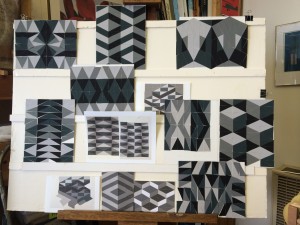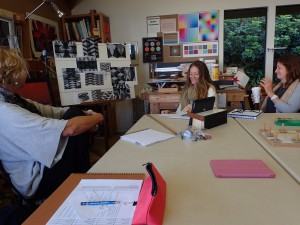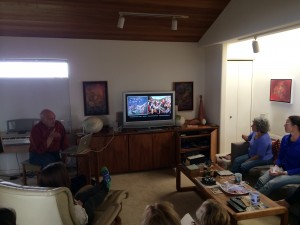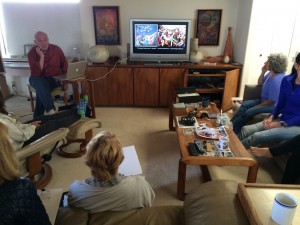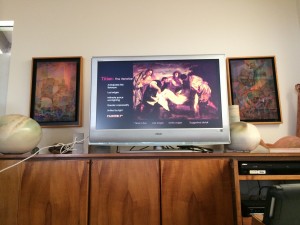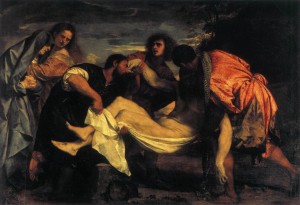The sixth session of the Advanced Drawing and Composition class for Winter 2016 was held on Wednesday, February 17. We went over our second composition assignment, discussed the importance of creative problem solving and how it affects composition, and watched a brief slide show on how the reigning beliefs shaped the aesthetic results of the Greek, Gothic, and Renaissance eras, among others. Enjoy the full post below, with audio and video provided by Valérie.
Homework assignment
1. Rework last week’s composition to exploit what you learned in critique.
2. You received the new assignment materials in class. Remember to consciously consider your options in your expansion phase, write them down in your convergence phase, and bring in that list along with your compositions next week.
[gview file=”https://dicknelsoncolor.com/wp-content/uploads/2016/02/CompAssign3plus.pdf”]
Class recap – some key ideas
Critique
Our class began with a critique of the last assignment, which had produced a number of unique interpretations. This provoked a very illuminating discussion on how composition fits into the six stages of problem solving, and it is very helpful to be able to identify the stages as we undertake the work.
Dick also talked about how composition and theme are related. This goes back to Dick’s statement, that if you don’t know what it is you are saying, if you don’t know what your core beliefs are, your work may not be coherent or consistent in its message.
Some of the highlights of the discussion, in both my note form, and quotes from Dick Nelson:
- It is important to understand the heuristics of problem solving. And what are heuristics? Being consciously aware of what it is you’re doing, while you’re doing it.
“I’m sure that each one of you can go back now and review your Expansion phase again, look at all of your options that you have. See, this is the difference between an educated man and an ignorant man: the educated man knows his options … and he is not a prisoner of his own ignorance. So if you go through this Expansion phase, and identify all your options, [then you will] know what your options are, and [can] make an intelligent choice. Then Converge, and that convergence sets the criteria. And that’s where this creative problem solving puts you in the driver’s seat, and you can come up with some crazy and incredible possibilities.”
- Gestalt tells a whole story, more than the parts individually
“So what was one of the most important ingredients in whether this was working or not?”
Class: “That the sum is greater than all the parts.”
“If I’m looking at these compositions, and I only see triangles, it’s like only seeing the A’s and the R’s and the N’s, and I don’t see what you’re trying to tell me. If you only see letters instead of words, there is no story.”
- Checklist: Could I create a sense of light and shade? Could I create depth? What can I do with perspective?
“The important thing is to have a list: have I really taken advantage of all the visual possibilities?“
- Exploit previous knowledge during the Expansion phase: check your Expansion phase ideas in the Development stage, then go back and Exploit what works
“Do you see what other phase has come into this? She must have said to herself, in the Expansion phase, is that one of the illusions I can create is one of light and shade, and by doing that, maybe it will distract you from the triangles. In order to do that, she had to do an Exploitation of what she learned in the color class, and had she not had that exposure, the chances are that maybe she could not have expanded this – she may have put down, “Ok, I would like to have a sense of light and shade, but I don’t know how to do it.’ But as far as I’m concerned, the other is of secondary importance: you can learn how to do it, but if you never ask the question ‘what other visual things might I be able to do?’, [you remain ignorant].”
- Organizing principle – Find your THEME, then organize around that. If ________________ is your theme, then how do your choices support that?
“But when you Converge on this, and you say, ‘Ok, I’m going to concentrate on a composition in which reverse gradation [is the focus]’ – do you see how that serves as an organizing principle? And then everything else must follow that. And if you don’t follow that, then in the inconsistencies, you lose the reading.”
Please listen to Valérie’s recording below for the full critique.
Slide show/lecture
We followed our coffee break with a brief slide show which some of the class had seen previously in last year’s art history class, Art is Us.
The main focus was showing how compositions reflect the beliefs of the artist and his times. This was illustrated in four different interpretations of a single theme (religious) and subject (the deposition of Christ) from periods in art history spanning over 200 years.
- Giotto – Late Gothic, anticipating Renaissance (1306)
- Raphael – High Renaissance (1507)
- Titian – Late Renaissance, anticipating the Baroque (1526)
- Pontormo – Mannerism (1526)
Dick also touched on other concepts important to understanding art history and composition. He summed up the lecture saying, “The point is to show you the relationship of what you believe and want to say, and how that will dictate so all parts relate. Know what you are trying to say.”
Here are some excerpts from the lecture:
“So the whole idea of composition has to do with what your belief is. [For example, the Gothic sculptors] didn’t sign their name, because that wasn’t important. It was an age of FAITH, not an age of REASON. So God was the measure of all things. Consequently, the figures were composed as part of the architecture.”
“If you don’t know what you’re trying to say … you know, some people will just look at the Gothic, and say ‘Oh isn’t that nice, I’m going to do Gothic kind of sculpture’ – yeah, well do you know why they did this? Why are you signing your name then? … All of the [Gothic] values were spiritual, rather than human.”
“In the High Renaissance, and why I’ve given you the module, is that the recognition of relationship becomes extremely important as Leonardo da Vinci draws man at the center of all things: humanism. And man is imposed in a geometric circle and square, showing the relative relationship of all parts to the whole. Using the square, or the circle, or modules like you’ve just done, creates a unification in which all of the parts are based on this module.”
“And yes, they’re still Christian, but for the first time, you could have a tragedy. You couldn’t have a tragedy until man was at a point at which he was responsible for his own actions. So he does an action, which unfortunately doesn’t work out for him, and it’s a tragedy.”
As Dick has said many times before, the key to understanding art is to ask one of the most important questions: “What was the artist trying to do?” Without knowing what was important to the artist, and what message they were trying to convey, it is very easy to misinterpret the final piece. And when we misinterpret, or misread the work, we often form a judgment prematurely, which has nothing to do with what the artist intended.
Again, to hear to the full lecture, please listen the recording below.
Homework
We finished up class by going over the new homework assignment, which is to create a modular composition using a grid as a template. There are two grids for this assignment, one is 2-dimensional, and the other is 3-dimensional, both of which we are to use to create a gray scale composition of shapes and panels/planes. Again, the criteria seem somewhat restrictive, but Dick is pushing us to find ways to be creative within a framework. What starts out as feeling very limiting can often end up being the springboard to results you never could have imagined.
One of the most important parts of the homework is to write down any revelations or a-haa’s which form as we do the assignment. This is to help us recognize where we tend to limit ourselves, with hidden preconceptions and beliefs that shut off our creativity without our notice. By writing down our realizations as they arise, we will take full advantage of the expansion phase, and reveal other options which we may have ignored in the beginning. It will be interesting to see what ‘comes to light’!
Video: 3D Grid Assignment (17:24)
Audio: Critique; Composition in art history; Grid assignments
Class materials
Dick showed this slideshow from last year’s art history class, emphasizing perspective, composition and how art reflects the culture and beliefs of the artist and his time.
